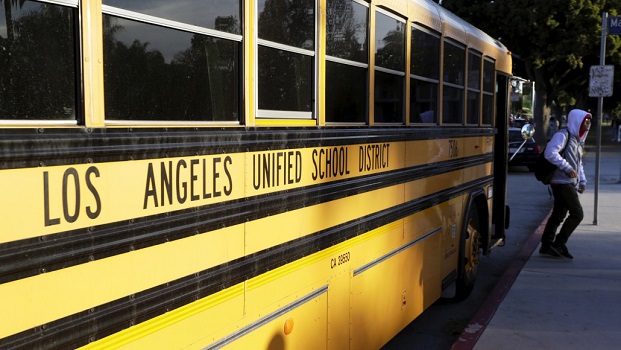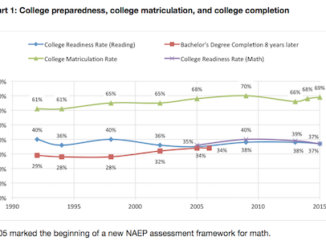
In 2011, the Los Angeles Unified School District (LAUSD) reported a high school graduation rate just over 60 percent, almost 15 percentage points below the national average. The second-largest school district in the United States clearly struggled to serve its students, more than three quarters of whom receive free or reduced-price lunch and over a quarter of whom are English learners.
After five years of steady growth, the class of 2016 has narrowed that graduation gap between the district and the country to only six percentage points, even while the national graduation rate itself surged to an all-time high. The Department of Education reported a 2015 graduation rate of over 80 percent for all students, while the rates among disadvantaged students continued to rise as well.
School districts and their superintendents cheered the improvement, both in LA and nationally, but many education observers reacted cautiously. A Washington Post headline summarizes this dissonance: “U.S. high school graduation rate is up — but there’s a warning label attached.” In the midst of a national conversation about climbing graduation rates, LAUSD provides a useful illustration of the many ways states and districts are trying to balance the need for rigor with a desire for every student to succeed.
| A-G requirements | |
| A. History/Social science | 2 years |
| B. English | 4 years |
| C. Mathematics | 3 years |
| D. Laboratory science | 2 years |
| E. Language other than English | 2 years* |
| F. Visual and performing arts | 1 year |
| G. College preparatory elective | 1 year |
| *Or equivalent Source: University of California |
|
Increasing rigor for college and career readiness
Like many other school systems, LAUSD has adjusted its graduation requirements to promote college and career readiness for students. The 2015-16 school year marked the implementation of a long-planned alignment of the LAUSD requirements with the minimum entrance requirements for the California State University and University of California systems, commonly known as the A-Gs. Compared to the 2014-2015 graduation requirements, the A-Gs include an additional year of math, through at least Algebra 2, and two additional years of foreign language. The A-Gs also add a new mandate for a college preparatory elective, such as statistics or computer science.
Theoretically, more stringent graduation requirements coupled with stable levels of academic performance should have led to declines in the graduation rate. At the end of the fall semester in 2015, exactly as expected, it seemed like the rate would indeed drop by the spring: Only 54 percent of LAUSD seniors were on track for graduation. Instead, by the end of the year, the graduation rate increased by five percentage points from the class of 2015 to the class of 2016. What happened?
“All hands on deck” versus credit recovery
On the one hand, LAUSD Superintendent Michelle King credited the “all-hands-on-deck, laser-like focus on ensuring that our kids get to graduation” among district teachers, counselors, and administrators for the higher graduation rate. As part of that “all hands on deck” push, King oversaw a $15 million investment in credit recovery programs, including a sizeable investment in online courses, for students who had failed a class in previous years. These online options were the deciding factor for 13 percent of the LAUSD graduating class, as reported by the Los Angeles Times, raising suspicions. This parallels trends in New York, Louisiana, California, Florida, and others in which districts are increasingly shifting to online courses to help struggling students.
Suspicions about these courses appear warranted. A recent study in Chicago showed high school students who completed online courses were 10 percent less likely to demonstrate competency in the subject than those in face-to-face credit recovery programs, and reported liking the subject less and feeling less confident of their grasp on the material.
Despite these nationwide concerns over whether increasing graduation rates reflect real progress, dismissing LAUSD’s and the nation’s progress on graduation rates may be premature, though, given the policy context that is often overlooked in these discussions.
The rigor of A-Gs
Despite LAUSD’s advertised alignment of graduation requirements to the A-G course list, the district did not fully match the university system’s requirements. For university entry, students must have completed required courses with at least a grade of “C.” LAUSD only required a “D” for graduation. This “D” standard meant that many students did not graduate the district college-ready. Only 47 percent of LAUSD graduates would have cleared the “C” mark if it had been implemented.
To examine the rigor of the A-G alignment, we can look at local college remediation rates. With college readiness as the goal, remediation rates offer the most immediate indicator of success. As LAUSD’s class of 2016 entered college in the fall, the California State University campus in Los Angeles reported a first-time freshman remediation rate of 51.7 percent in math and 47.2 percent in English. Those remediation rates are amongst those who did receive “Cs” and therefore were eligible for CSU admission, indicating the alignment may not be as strong as touted.
That being said, those remediation rates represent a sizeable 9.1 percentage point reduction in math and double that in English over the last five years. Credit for this accomplishment probably must be shared between King and the district for better aligning its graduation requirements and the California State University system for reducing its own rate amidst a national conversation about remediation, but these statistics certainly bolster King’s claim of rigor.
California’s exit exam on hold
Beginning with the class of 2016, California suspended its high school exit exam as a requirement for a diploma. In this way, California fits a national trend in which only 13 states still require an exit exam for graduation, down from 27 in 2003. A New America report concluded, “Exit exams have tended to add little value for most students but have imposed costs on already at-risk ones.”
When in place, the California High School Exit Exam potentially posed a barrier to graduation for many students who had already completed all other graduation requirements. Despite the option to retake the exam multiple times, 4.2 percent of California students in the class of 2015 failed to pass by the end of their senior year and were prevented from receiving diplomas. LAUSD numbers, though not available, are likely even higher judging from past years.
2017 and beyond
LAUSD joins the ranks of districts and states across the country combining different policy changes to improve graduation rates. Pundits’ dismissive characterizations of the surge often reduce the cumulative effort to a narrow critique of dubious online credit recovery efforts. While skepticism is warranted, it overlooks other simultaneous—and laudable—efforts from educators and policymakers occurring in the space between high school and college.
As we conclude the 2016-17 school year with pomp and circumstance, the ultimate question is whether states and districts can continue to sustain these levels and perhaps improve upon them in years ahead.
Michael Hansen is the Herman and George R. Brown Chair and Director – Brown Center on Education Policy Senior Fellow at Brookings.



